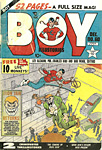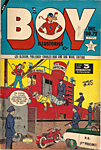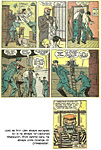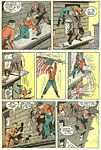THE CHAMPION BAD GUY
The Worst of the Worst Was the Absolute Worst—Iron Jaw
For as long as I can remember, we've entertained as a culture a morbid preoccupation with bad guys. J.R. Ewing and Darth Vader come immediately to mind as exemplars of the breed. Lately, Dexter. The classic is Robin Hood, a highwayman who lurked along the roads through Sherwood Forest. He robbed from the rich to gave to the poor, you say? Well, who else would he rob? The poor didn’t have anything to take.
These days, it’s vampires and zombies. Blood-suckers and brain-eaters. Some tv series and movies lately have made romantic icons out of handsome young men of deadly pallor who, sadly, live forever, but they’re vampires just the same, bad guys almost by definition.
One of the most successful comic book series of recent years was 100 Bullets in which a mysterious messenger gave some possibly deserving lout an untraceable pistol and enough bullets to avenge himself on whoever had been dumping on him all his life. But they were all bad guys.
We like the bad guys. We dote on outlaw personalities. From Billy the Kid to Dick Cheney. From the Swamp Fox of colonial times to Charlie Wilson and the Afghan resistence to Soviet occupation. It’s always been that way. It may, in fact, be a distinctly American trait.
The bad guys "get away with it." Or try to. They are the ultimate defiers of authority. After all, the country started that way, defying authority—committing a revolution and then setting up a whole different nation. And in the land of the free and home of the brave, the Individual is paramount so it is perhaps understandable that we admire individuals who, like the classic villains, defy all social convention (as well as law and order—in other words, all authority) to get their own way.
Sometimes the defiers are heroic. American mythology fosters the idea of the individual as hero. The traditional hero of the Western is the lone rider, who rights wrongs single-handedly, before ambling off into a blazing sunset. The lone rider usually acts without the help of local law enforcement officers—and always in opposition to them if they are corrupt (as they often are). Thus, the individual is portrayed as supreme, his instincts finer and better—and righter—than any societal institution's.
The vigilante is only a step away. And once you have the good guys acting solely on their own conviction without the support of duly constituted authority, the heroes are different from the villains only in motivation, a sometimes dubious criteria for assessing redeeming social worth.
So we're stuck with a kind of national psychic ambiguity about those who defy authority. Do we admire them or do we despise them?
And in these days of darkened heroes—of a psychotic Batman and an equally demented Punisher—it's harder and harder to tell the good guys from the bad guys without a program.
Some years ago, two of the many periodicals that litter the comic book landscape, Hero Illustrated and Wizard, undertook to provide the program.
Hero Special Edition on Comic Book Villains (April 1994) is a compact survey of the field that begins with an interview with Stephen King. Mike Tiefenbacher covers "The Evilution of the Comic Villain" with aplomb and insight, bringing to bear his extensive knowledge of comics. A light-hearted look at the "goofiest villains" supplies comic relief at the end of the book. But the heavy duty section is a listing of the 25 "baddest of the bad, the greatest comic book villains of all time."
Wizard's nearly concurrent 128-page treatment of the subject is about thirty pages larger than the Hero book and provides, therefore, more detail. The Dark Book (as it is called) looks at villainy in historical periods (Golden Age, Silver Age, Modern Age), pausing at intervals to explore monsters, the anti-hero, organized malefactory, aliens, bad guy teams, and so on. Written mostly by Avatar’s William Christensen and Mark Seifert, the volume also includes an opening essay by John Byrne and closing comment by Peter David.
Discussing what makes the best villains, most of those quoted on the matter agree that a good bad guy must have as rounded a personality as any other character. Stan Lee, for instance, says: "I don't just want villains who are bad guys. I want to know why they're bad ... what their weaknesses are ... what they were like as children, why they turned out this way. I want them to be real people."
King agrees: "They have to be real people. ... They've got to think they're good guys ... [They're warped mentally and as a result] see themselves as not just good guys but as saints [who are] being persecuted by all these evil people in the world."
Both Byrne and Tiefenbacher observe that villainy has changed. The bad guys used to be thieves, Byrne says; but in recent times, they've changed into blood-thirsty killers whose sole motivation is often simply to murder the hero. Tiefenbacher notes that since every hero requires a couple dozen villains to do battle with over the years of his career, "it becomes obvious that evil outnumbers good ... [but] since comic book Earth has yet to collapse into lawless chaos, we must infer that this means that good is stronger than evil even when outnumbered." But, he goes on, the evil has become more colossal lately and the evil-doers frequently escape punishment because they must be kept in the wings for return engagements.
Riveting as all this is, I am compelled to dash in at this point to recall a villain that neither publication mentions (despite my exhaustive exegesis to Christensen, who, at the time, was in my home town, doubling as a comic book back-issue mogul whose store I frequented and who subsequently became a publisher as Avatar). No catalogue of anything is going to include everything than everyone would list, but I can't understand how this August assemblage of experts missed Iron Jaw.
Iron Jaw, a name that still raises the hair on the back of my neck.
A champion baddie of the Golden Age, Iron Jaw may have been ahead of his time, the prototype of today's souless super thugs. He was one of few transgressors in those days who made encore appearances. He was eventually motivated not by greed or by a desire for power (the entire gamut of motives for most villains until the Silver Age) but by the obsession to murder the good guy who repeatedly apprehended him and threw him in the hoosegow. Sometimes, instead of being captured, he died horribly in a ghastly conflagration the inadvertent result of some scheme of his own gone awry. But he always escaped or came back to life (because he hadn’t really been killed: it only appeared that he had been). In all of this, as you can plainly see, he was a thoroughly modern—i.e., contemporary—villain.
Iron Jaw appeared exclusively in the pages of Boy Illustories, a Lev Gleason comic book that started in April 1942 (with No. 3, Nos. 1 and 2 belonging to the newly displaced Captain Battle), ended in 1956 (with No. 119), and featured almost exclusively the exploits of an athletic lad named Chuck Chandler, who made a name for himself as Crimebuster. CB (as he was usually denominated by friend and foe alike) was no superhero, but he wore a costume, a red-white-and-blue hockey uniform, for most of his career. The antics of CB's pet monkey, Squeeks, enlivened the adventures, which were otherwise fairly grim—even grisly—affairs.
Under the aegis of editor-writer Charles Biro, the Gleason criminals were unusually craven and unscrupulous even by present-day standards. Murder and assorted mayhem thrived in the pages of Boy, as they did in the other Lev Gleason titles, which included the first of the crime comics that so appalled Fredric Wertham, Crime Does Not Pay, a concoction of Biro and fellow editor-writer artist Bob Wood.
Journalist Joe Brancatelli, writing in The World Encyclopedia of Comics, put Biro in the same class of transformer and trend-setter as Jack Kirby, saying: “If Jack Kirby was the most important artistic force in comics during the 1940s, Biro certainly proved to be the finest editor and writer. While others were providing escapist fantasy in their comic books, Charles Biro decided his books would be different and better. He even dubbed them ‘Illustories,’ but the name never caught on. Throughout his 16-year stint as editorial director and chief writer at Lev Gleason, Biro proved to be the most innovative and certainly most advanced writer in the comic book field.” To which comics historian Ron Goulart added: “Biro cooked up formats and techniques that influenced the entire industry and are still in evidence.”
As a cartoonist, Biro entered the profession drawing bigfoot comedy. But in 1936, he joined the Harry “A” Chesler comics packaging shop where he soon functioned in the ways that determined the rest of his career in comic books: he not only drew but wrote stories, and became supervisor of the shop’s production. He then joined MLJ Comics in 1939 as artistic supervisor and writer and artist, moving to Gleason in 1941. At MLJ, Biro had abandoned bigfoot for “little foot” cartooning—namely, “a blend of action, violence, bloodshed and slinky sex” saith Goulart. These propensities he took with him to Gleason, where wrote and edited Daredevil, Boy, and the aforementioned Crime Does Not Pay—all innovative concepts executed with great verve.
Legend has it that Crime Does Not Pay “began when Bob Wood and Biro were swapping yarns in a bar and decided that gangsters and criminals would provide an never-ending flow of new stories for a comic book. Grabbing the name from a popular series of MGM live-action shorts of the 1930s, the pair conspired to rename [another Gleason comic] Silverstreak ,calling it Crime Does Not Pay,” a title that debuted in July 1942 as No. 22 (Silverstreak’s numbering went to No. 21).
The underworld had a mean and cruel streak in these books, and the denizens of that world were greedy and cowardly folk, who, driven to desperation when pursued by the likes of Crimebuster, Daredevil, or the Little Wise Guys (Daredevil’s version of the Newsboy Legion, which eventually elbowed the title character out of his own book), committed wanton acts of brutality in their desperation. It was a world wholly foreign to my young imagination. It was, therefore, thoroughly—hypnotically— fascinating.
The most murderous brute of all was, without question, Iron Jaw, CB's arch enemy and, in fact, the person who inspired young Chandler's fight against crime. Like many scoundrels in the early 1940s, Iron Jaw was a Nazi, and as a loyal and dutiful factotum of the party, he sought to silence Chandler's father, a governmental official who was revealing to Americans the Nazi atrocities in the days before we went to war. Iron Jaw shoots the senior Chandler but doesn't quite kill him. Later, in the hospital, the blackguard takes the place of the surgeon operating on Chandler and deliberately botches the procedure, murdering Chandler on the operating table.
At this gruesome turn of events, young Chuck races (improbably) from a hockey game in the states to France in order to rescue his mother from the threatening machinations of Iron Jaw. But Nazis catch up to the fleeing pair as they cross the Atlantic en route to the U.S. Hitler’s minions torpedo their ship and machine-gun the survivors in the water, killing Chuck's mother. When Iron Jaw hears about it, he gloats and rejoices. Wounded but alive in the water, Chuck vows vengeance, and Crimebuster is born. He is so dedicated to his mission that he never takes time to slip out of his hockey togs into something resembling conventional street garb. Not until years later does he give up his hockey shorts and don long pants. (And in No. 111 of the title, he finally decides to give up the nickname Crimebuster and pass among us as Chuck Chandler. But he still wears his distinctive jersey with the big “C” on it—standing for Curtiss Tech, his school.)
CB met Iron Jaw again and again after the death of his father and mother. Old Shovel Snout proved nearly invincible. He had no costume—no chains or spikes or cape. He didn’t shoot bolts of lightning from his fingertips or launch force fields of assault energy from the palms of his hands. But physically, he was among the most powerful of men. He was also ingenious, daring, and completely without moral sense or compunction. His hatred for Crimebuster developed into a full-scale mania, and when in the grip of his madness, Iron Jaw was an irresistible force.
 |
 |
To pit a mere youth, even one of CB's considerable athletic prowess, against such a maniacal powerhouse is to court disaster for the youth. And Biro, recognizing a good thing, arranged this courtship 50 times in the 116 issues of Boy in which CB appeared. Some of their physical encounters are epic David and Goliath confrontations—the monomaniacal Iron Jaw, as unstoppable as a Sherman tank, towering over CB, who, through cunning and sheer agility, manages to defeat the fiend. Their fights were usually depicted blow-by-blow in nearly continuous action sequences—a startling departure from the usual Gleason-Biro practice of overloading the panels with verbose speech balloons. The contrast in narrative manner was dramatic, adding suspense and danger to the battle taking place before us.
Iron Jaw was clearly evil incarnate. His brute power, his fiendish dedication to lawless rampaging, and his compunctionless acts made him genuinely terrifying. And his hideous visage contributed to the terror he inspired.
Iron
Jaw was so christened because the lower half of his face had been horribly
disfigured while he was a soldier in the Kaiser’s army during World War I. His
closest friend (as CB put it when telling the story) “was a weasel of a corporal
named Schicklgruber, a rat who later became der fuehrer.” The two plot
the undoing of a superior officer they mutually despise. Iron Jaw, known then
as Von Schmidt, shoots the officer in the back, but the mortally wounded man
gets revenge: his last act is to hurl a grenade at Von Schmidt and
Schicklgruber. Only Von Schmidt suffers any damage: his jaw is blow away and
subsequently replaced by a saw-toothed metal construction, hence his nom de
guerre. In one issue, he removes the device and we are treated to a view of
his withered chin. It was enough to give young readers nightmares. 
Biro drew some of the Gleason comic book tales, most of which he wrote, and he may have drawn the one in which Iron Jaw appears without his metal apparatus (in Boy No. 60, December 1950), but most observers declare that Biro drew nothing but covers for Gleason titles after about 1942. Persistent lore claims that every artist on Crimebuster was required to paste onto his rendering of the character a photostat of Biro’s version of CB’s face, which Biro had drawn from a half-dozen angles for the purpose. I suspect there’s some truthiness in this contention: it explains CB’s rather wooden, unchanging albeit serious expression in nearly every early issue of the title. But as other highly competent artists were recruited by Biro, we began to see improvement in CB’s portraits.
The most widely recognized of CB’s interpreters was Norman Maurer, who drew in the manner of Milton Caniff and worked on the title for ten years (1943-53). (Krause’s Standard Catalog of Comic Books reports that Maurer was the artist on the first issue, but he would have been only a few months shy of 16 at the time. He was a Biro protégé but I doubt Biro would have entrusted his brainchild to a rank beginner however talented.) William Overgard , Maurer’s exact contemporary and another Caniffian, is probably the next most familiar artist on Crimebuster—three-four years, 1950-53. A number of other eventual stellar names were associated briefly with the feature over the years—Dan Barry, Bob Fujitani, Frank Bolle, George Tuska, Jerry Grandenetti, and, in 1955, Joe Kubert, producing a distinctively Kubertian CB. One of the best in the Maurer-Caniff manner was Hy Mankin, whose heavily applied chiaroscuro cast menacing shadows over Iron Jaw whenever he invaded the premises.
Iron Jaw’s last appearances in the title were the strangest ever associated with a villain. Years before, a petty criminal named Sniffer wandered into CB’s venue, and his amusing though still sinister antics attracted a following that would not be denied; after being properly chastised with jail time, Sniffer became a somewhat reformed petty crook, dabbling in mere confidence games and get-rich-quick schemes rather than outright crime—nothing that would get him arrested in most places. Not crime but comedy was now Sniffer’s forte, and he regularly appeared in Boy in a short humorous feature between Crimebuster epics. Occasionally, Sniffer was joined in these endeavors by none other than the once bloodcurdling Iron Jaw, who, for the occasion, was about as reformed as Sniffer. Unlikely as it seems, Iron Jaw finished his career as a comedian. And by his appearance in No. 112 Sniffer story, he’d even managed to grow a regular flesh and bone jaw, replacing his iron choppers. In short, the terror of the funnybooks was now just funny and not terrifying at all. What a come-down from his reign of unholy brutality and sadistic horror.
We don't see Iron Jaw’s ilk as a brute-force bad guy in comic books again until the last decade or so, when murderous conscienceless super villains have replaced routinely conniving miscreants almost entirely. Dr. Doom might be Iron Jaw’s lineal descendent (but he’s not nearly as savage in person as Iron Jaw was). You might say Iron Jaw showed the way for all of them. In any event, he deserves a place in history even if he wasn't the bellwether I think he was.
To conclude this interlude in yesteryear, here’s a Crimebuster-Iron Jaw gallery.
 |
 |
 |
 |
 |
 |
 |
 |
 |
 |
 |
 |
 |
 |
